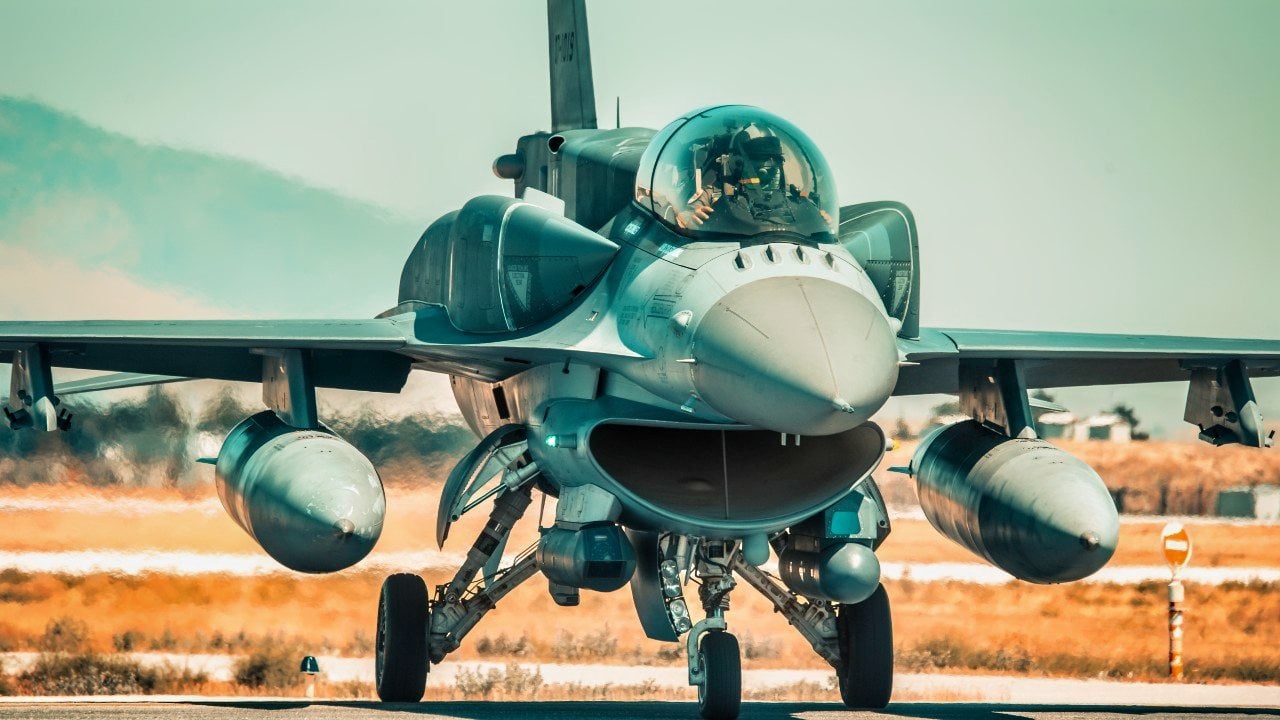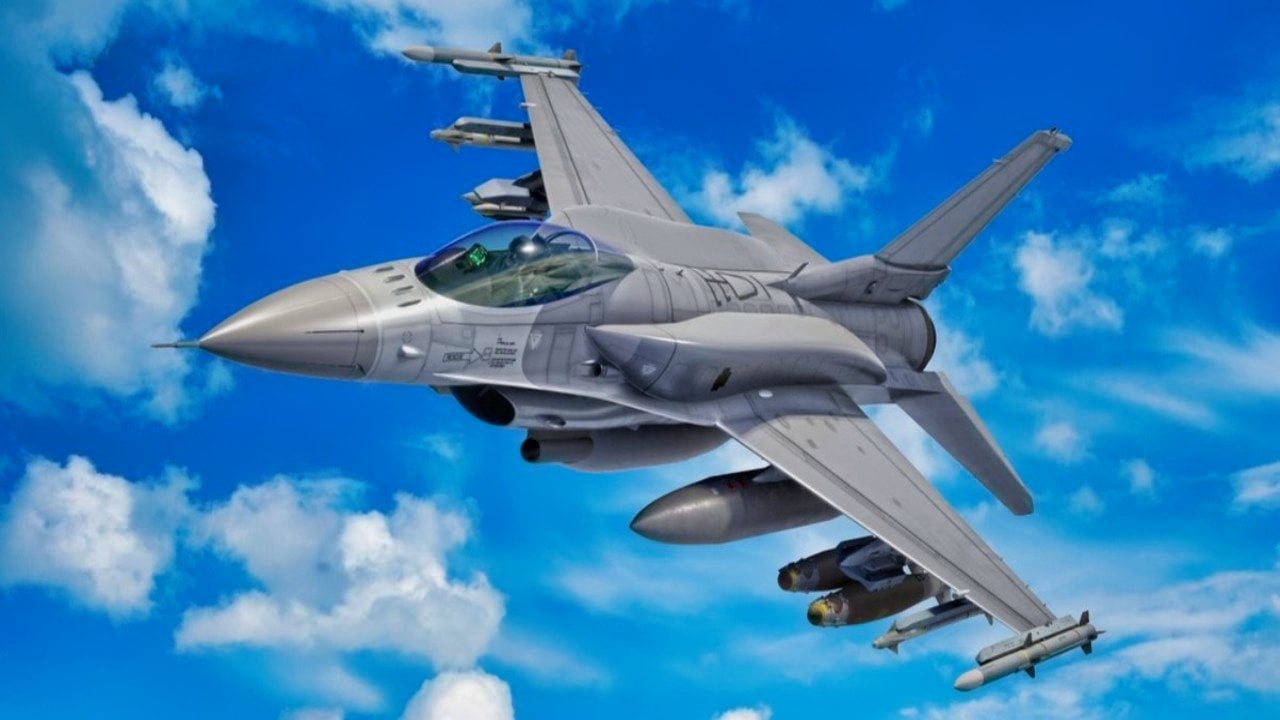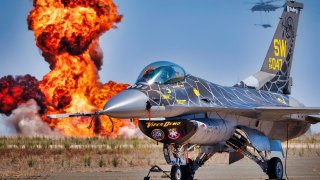This F-16 Fighter Barely Dodged 6 Surface-to-Air Missiles
During the opening days of Operation Desert Storm, one American F-16 pilot overcame incredible odds.
During the opening days of Operation Desert Storm, one American F-16 pilot overcame incredible odds by dodging not just one surface-to-air missile fired at him, but six in a row — and all without the benefit of flares or chaff to help. Although today we often dismiss Saddam Hussein’s Iraqi military as hopelessly outmatched in this fight, footage captured from inside the aircraft offers a unique insight into the life or death struggle fighter pilots actually faced in the skies over Iraq.
AN INTRICATE BALLET OF DESTRUCTIVE CAPACITY
From our vantage point some 30 years later, Desert Storm seems like little more than an appetizer for future conflicts in Iraq, and as such, it tends to garner less attention than more recent (and ongoing) conflicts in the Middle East. As a result, it’s easy to forget just how massive, intricate, and logistically challenging the Coalition’s speedy victory over Saddam Hussein’s Iraqi regime really was.
While there’s no question that the Iraqi military was outclassed in every appreciable way by the massive force fielded against it, Iraq was not without serious and sizeable defenses. Iraq’s capital, Baghdad, may have been one of the most heavily defended cities on the planet when Coalition aircraft first screamed across Iraq’s border on 17 January 1991. It may be fair to say that the Coalition Force’s victory was a foregone conclusion as the Gulf War began, but the tactical and strategic domination of the Iraqi forces was not.
For months leading up to the first day of the conflict, Coalition aircraft would fly in huge groups near the Iraqi border, ensuring that when the actual campaign began, massing formations of aircraft wouldn’t serve as notice to the Iraqi military. While this is an often-ignored aspect of the conflict, this massive coordinated display of airpower was an incredible undertaking in itself, requiring close coordination between military forces and their respective nations.
On the eve of the first day of the air campaign in Iraq, General Norman Schwarzkopf’s coalition had a whopping 2,430 military aircraft at its disposal. Keen to handily defeat his opponent, the American general began the Gulf War in the skies, with five straight weeks of airstrikes and combat patrols bolstered by naval bombardments that were meant to crush Iraq’s sizeable collection of air defense assets, neuter the Iraqi Navy’s ability to deploy forces by sea, and pave the way for the ground troops and heavy armor that were soon to follow.
With more than 16,000 surface-to-air missiles (SAMs) in Iraq’s arsenal and America’s fleet of stealth F-117 Nighthawks reserved for only specific mission sets, it was largely up to American F-4s to hunt down and take out SAM sites in what are commonly referred to as “Wild Weasel” missions. The F-4G was a purpose-built iteration of the Phantom for this role, but the job was still incredibly dangerous. These stealth-less aircraft would fly into enemy airspace and identify Iraqi air defense systems as they came online, often deploying anti-radiation missiles like the AGM-88 HARM to sniff out and destroy their radar arrays.
However, sending in the Wild Weasels ahead of airstrike packages wasn’t always feasible, and even when it was, the nature of combat operations would sometimes force pilots to divert from their intended flight plan–and fly right into Iraqi defenses eagerly awaiting an opportunity to shoot down an American aircraft.
THE LARGEST F-16 STRIKE IN HISTORY
Thanks to a vast array of overlapping air defense systems and anti-aircraft artillery, supplemented by both radar-guided and optical surface-to-air missiles, the capital of Iraq had only seen airstrikes from the stealth F-117 Nighthawk in the first two days of the fighting, but on day three, the U.S. Air Force was coming in force.
A whopping 72 F-16 Fighting Falcons, each equipped with two 2,000-pound Mk 84 bombs would make up the main body of the strike force, tasked with leveling government targets and Tawaitha nuclear reactor just south of the city. Eight F-15 Eagles flew alongside the F-16s to maintain air superiority (engage any enemy fighters), eight more F-4G Wild Weasels were tasked with taking out air defense systems, and two EF-111 Raven electronic warfare aircraft would jam enemy radar while the Wild Weasels hunted them down. It would be the largest airstrike operation of the war, and the largest F-16 mission in history.
However, the challenges of deploying all these aircraft from four different installations, coordinating them in the sky, and refueling them at necessary intervals were daunting. To make matters worse, some command elements received their orders late, offering little time to prepare and practically no time for pilots to recuperate after coming off of the numerous combat sorties they’d been flying for two days prior. In other words, it was an incredibly complex and dangerous operation being executed with too little preparation by pilots who were already exhausted. Even before they climbed into their cockpits, the American pilots knew what they were about to do was the combat equivalent of trying to ice skate up a hill, but they were also supremely confident in their aircraft, their capabilities, and one another.
“We felt pretty confident it wouldn’t be as difficult as it seemed on paper,” later recounted F-16 pilot Maj. Jeffrey S. Tice. Tice would be shot down and taken prisoner before the operation was over.
THE MISSION GOES AWRY
The mission called for the fleet of F-16s to begin by engaging targets on the outskirts of the city and work their way in, which would give enemy air defense systems ample opportunity to target and engage the fighters. Unfortunately, bad weather hampering refueling efforts and some degree of confusion compromised the Wild Weasels’ portion of the mission, forcing them to leave a fair portion of their mission objectives incomplete and depart without accompanying the F-16s into the inner portion of the city.

Anti-aircraft fire coming up from the ground was so thick some pilots likened it to seeing an overcast day. The EF-111s found that there were simply too many anti-aircraft systems in the region to effectively jam them all, leaving huge swaths of the strike force vulnerable to the sizeable Iraqi missile arsenal. Before long, the F-15Cs tasked with escorting the F-16s were forced to bug out–with no enemy aircraft to fight and the sky filling with anti-aircraft fire and surface-to-air missiles, they had become little more than additional targets for the Iraqis to fire at. Soon, the decision was made to pull the entire strike force out of Bagdhad airspace.
As the fleet of F-16s flooded out of Bagdhad, Iraqi surface-to-air missiles flew in all directions, but American pilots with iron will and steel composure continued to find their targets and drop ordnance. To that point, training on how to avoid SAMs had been largely academic for Air Force pilots, learning to dodge inbound missiles just about four seconds before they’d make contact to both make them miss and ensure the aircraft was outside the approximately 33-foot blast radius when the missile detonated. The training may have been out of a book, but it wasn’t long before pilots had to put it to good use.
Contrails made a spiderweb of the sky as a whopping 27 surface-to-air missiles launched in less than three minutes. In radio recordings, you can hear Tice call out for another pilot to “break right,” but it was too late. Captain Mike Roberts’ F-16 had been hit. Not long after, another missile careened toward Tice. He executed a barrel roll and managed to avoid a direct hit but the missile exploded close enough to the aircraft to shower it with shrapnel. He was eventually able to get the F-16 back under control as backup systems came online, but the aircraft would not make it home.
“Essentially the back end of my airplane looked like an exploding cigar. There was stuff burning and I couldn’t do anything about it. The airplane was still producing thrust. I let it take me as far as it was going to go,” said Tice.
ONE F-16 DODGES 6 MISSILES
The fleet of 72 F-16s at the onset of the mission was made up of groups from two wings, with 56 hailing from 388th Tactical Fighter Wing out of Al Minhad in the United Arab Emirates and the remaining 16 from the 401st Tactical Fighter Wing out of Doha in Qatar. Among that small party from the 401st was Major Emmett Tullia, flying under the callsign “Stroke 3.”
As he made his approach, a cockpit warning went off to tell Tullia that he had been targetted by a radar-guided surface-to-air missile. In textbook fashion, he made the telephone-pole-sized missile miss with a hard turn, but noted that his chaff and flares seemed to not affect the missile’s flight. Undaunted by the close call, Tullia pressed on and was among the few F-16 pilots who were able to brave the onslaught of Iraqi defenses and find his target, deploying both 2,000-pound bombs over an oil refinery.

He turned his F-16 south to get out of the city, only to find that he’d been targetted once again. This time, three missiles were heading his way. Again, Stroke 3 took evasive action, dodging the incoming SA-3 missiles and flying straight into a lock from an even more capable SA-6 surface-to-air missile.


